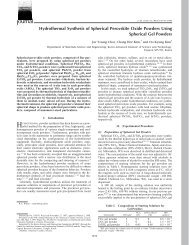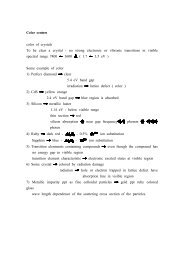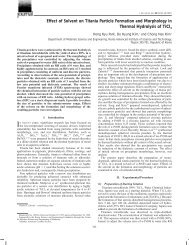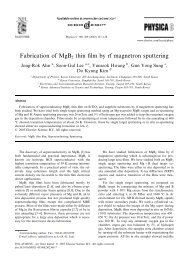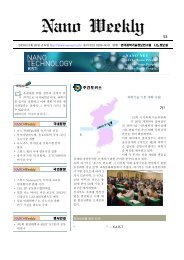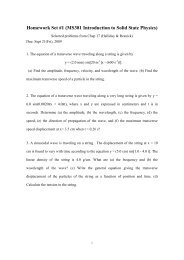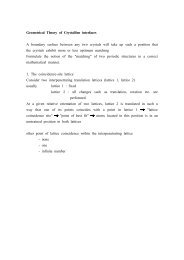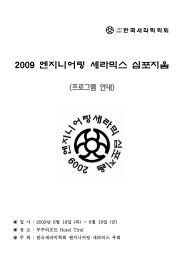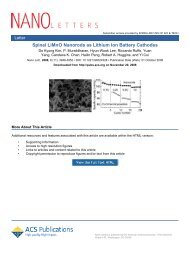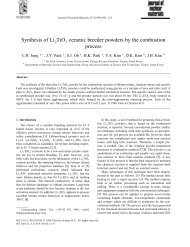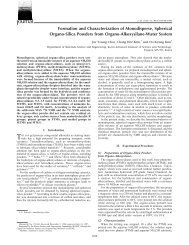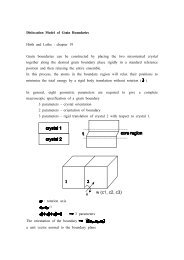Low-Temperature Synthesis of Eu-Doped Cubic Phase BaAl2S4 ...
Low-Temperature Synthesis of Eu-Doped Cubic Phase BaAl2S4 ...
Low-Temperature Synthesis of Eu-Doped Cubic Phase BaAl2S4 ...
Create successful ePaper yourself
Turn your PDF publications into a flip-book with our unique Google optimized e-Paper software.
<strong>Low</strong>-<strong>Temperature</strong> <strong>Synthesis</strong> <strong>of</strong> <strong>Eu</strong>-<strong>Doped</strong> <strong>Cubic</strong> <strong>Phase</strong> BaAl 2S 4<br />
Blue Phosphor Using Liquid-<strong>Phase</strong> Reaction<br />
Yang Hwi Cho, a Do Hyung Park, b and Byung Tae Ahn a, * ,z<br />
a<br />
Department <strong>of</strong> Materials Science and Engineering, Korea Advanced Institute <strong>of</strong> Science and Technology,<br />
Yuseong-gu, Daejeon 305-701, Korea<br />
b<br />
Samsung SDI, Yongin, Gyeonggi, 446-577, Korea<br />
A <strong>Eu</strong>-doped BaAl 2S 4 phosphor was synthesized by a liquid-phase reaction using BaS, <strong>Eu</strong>S, Al, and S, where Al acts as a liquid<br />
source during the reaction, instead <strong>of</strong> Al 2S 3. The synthetic temperature <strong>of</strong> the cubic BaAl 2S 4 phase could be reduced to as low as<br />
660°C, considerably lower than that required for a phosphor synthesized via a solid-state reaction using BaS, <strong>Eu</strong>S, and Al 2S 3. The<br />
cubic BaAl 2S 4:<strong>Eu</strong> phosphor synthesized using the liquid phase showed larger grains and higher crystallinity. The photoluminescence<br />
<strong>of</strong> the cubic BaAl 2S 4:<strong>Eu</strong> phosphor showed a blue emission centered at 470 nm with a CIE color coordinate at x = 0.12,<br />
y = 0.11. In addition to well-defined blue color, the PL intensity was doubled relative to the solid-state reaction case.<br />
© 2007 The Electrochemical Society. DOI: 10.1149/1.2804380 All rights reserved.<br />
Manuscript submitted July 11, 2007; revised manuscript received October 8, 2007. Available electronically November 26, 2007.<br />
The ternary compound semiconductor BaAl 2S 4 has an optical<br />
bandgap <strong>of</strong> 3.99 eV, which is suitable for application to optoelectronic<br />
devices operating at the violet-blue wavelength. 1-3 In particular,<br />
<strong>Eu</strong>-doped BaAl 2S 4 BaAl 2S 4:<strong>Eu</strong> is known to a blue emitting<br />
phosphor centered at 467 nm. 1,4 BaAl 2S 4:<strong>Eu</strong> phosphors have received<br />
attention for application in inorganic electroluminescence devices,<br />
because BaAl 2S 4:<strong>Eu</strong> thin films in EL devices show a blue<br />
emission at 470 nm with high brightness. 5-8<br />
BaAl 2S 4:<strong>Eu</strong> phosphors are commonly synthesized by a solidstate<br />
reaction <strong>of</strong> <strong>Eu</strong>-doped BaS and Al 2S 3. 1,2,4,9 However, solid-state<br />
synthesis <strong>of</strong> the cubic BaAl 2S 4 phase requires temperatures above<br />
900°C. Secondary phases that reduce the color purity <strong>of</strong> BaAl 2S 4<br />
exist when the reaction temperature is below 900°C. In addition to<br />
high-temperature synthesis, handling starting material, such as<br />
Al 2S 3, is difficult because it reacts easily with water vapor or oxygen.<br />
The selection <strong>of</strong> Al and S instead <strong>of</strong> Al 2S 3 can reduce this<br />
difficulty. 10<br />
Because the melting point <strong>of</strong> Al is lower than the reaction temperature<br />
<strong>of</strong> the cubic BaAl 2S 4, the existence <strong>of</strong> liquid Al can enhance<br />
the reactivity <strong>of</strong> the reactants. The liquid in the reactant acts<br />
as a medium that allows fast transportation <strong>of</strong> the starting materials<br />
through the liquid. 11<br />
In this study, BaAl 2S 4:<strong>Eu</strong> blue phosphor is synthesized utilizing<br />
Al melt instead <strong>of</strong> Al 2S 3 and the structure and microstructural<br />
changes <strong>of</strong> the phosphor are investigated.<br />
Experimental<br />
A <strong>BaAl2S4</strong>:<strong>Eu</strong> phosphor was synthesized from BaS Kojundo<br />
99.9%, <strong>Eu</strong>S Kojundo 99.9%, AlKojundo 99.99% up, and S<br />
Aldrich 99.99%. The ratio <strong>of</strong> BaS, <strong>Eu</strong>S, Al, and S was<br />
0.97:0.03:2:3 for 3 mol % <strong>Eu</strong> doping. To obtain pure <strong>BaAl2S4</strong> phase, excess sulfur was added to the starting materials. The starting<br />
materials were mixed in a mortar in air. The mixture was put into an<br />
alumina crucible, which was then placed into a quartz ampule. The<br />
quartz ampule was sealed under 10−3 torr vacuum. The mixture was<br />
reacted in a temperature range <strong>of</strong> 600–850°C for 12 h.<br />
For comparison, <strong>BaAl2S4</strong>:<strong>Eu</strong> was also synthesized form BaS,<br />
<strong>Eu</strong>S, and Al2S3 Kojundo 98%. The ratio <strong>of</strong> BaS, <strong>Eu</strong>S, and Al2S3 was 0.97:0.03:1. In this case, mixing was performed in Ar, because<br />
Al2S3 is easily hydrolyzed in moist air. The mixture was reacted in<br />
a temperature range <strong>of</strong> 600–850°C for 12 h.<br />
The phase was characterized by X-ray diffraction XRD operated<br />
at 40 kV and 45 mA using Cu K = 1.5405 Å radiation.<br />
The scanning range 2 was from 15 to 40°. The microstructure was<br />
* Electrochemical Society Active Member.<br />
z E-mail: btahn@kaist.ac.kr<br />
Journal <strong>of</strong> The Electrochemical Society, 155 1 J41-J44 2008<br />
0013-4651/2007/1551/J41/4/$23.00 © The Electrochemical Society<br />
analyzed via scanning electron microscopy SEM. The photoluminescent<br />
PL properties were measured under an excitation wavelength<br />
<strong>of</strong> 350 nm.<br />
Results and Discussion<br />
Figure 1 shows the XRD patterns <strong>of</strong> synthesized powders with<br />
various Al to S ratios in the reactant composition on the phase formation<br />
at 850°C. When the Al to S ratio is 2:3, which corresponds<br />
to the stoichiometric <strong>BaAl2S4</strong> composition, a cubic <strong>BaAl2S4</strong> and a<br />
secondary Ba2Al2S5 phase were formed. The major reaction can be<br />
expressed as<br />
BaS+2Al+3S=<strong>BaAl2S4</strong> The minor reaction can be expressed as 12<br />
BaS+Al+ 3<br />
2 S=1<br />
2 Ba 2Al 2S 5<br />
J41<br />
It is considered that S will not be fully incorporated due to a lack <strong>of</strong><br />
S supply when the Al to S ratio corresponds with the stoichiometric<br />
composition. When the Al to S ratio is 2:6, only cubic BaAl 2S 4<br />
phase is formed. Ba 2Al 2S 5 does not exist, suggesting that S is fully<br />
supplied. When the Al to S ratio is 2:9, BaS 3, sulfur-rich phase,<br />
appears in addition to BaAl 2S 4.<br />
Figure 2a shows the XRD patterns <strong>of</strong> the phosphors reacted with<br />
Al 2S 3 as a source material at various temperatures. At 600°C, the<br />
XRD peaks <strong>of</strong> the starting materials, BaS and Al 2S 3, are detected. At<br />
700°C, BaS and Al 2S 3 phases are reduced by reaction. The XRD<br />
peaks <strong>of</strong> the synthesized powders have low intensities and are not<br />
Figure 1. XRD patterns <strong>of</strong> synthesized powders with various Al to S ratios<br />
after heat-treatment at 850°C.
J42<br />
Journal <strong>of</strong> The Electrochemical Society, 155 1 J41-J44 2008<br />
Figure 2. XRD patterns <strong>of</strong> synthesized powders with various temperatures<br />
using a Al 2S 3 and b Al + S Al:S=2:6.<br />
clearly distinguished from the background. At 800°C, cubic<br />
BaAl 2S 4 phase and BaAl 4S 7 phase are formed. The BaAl 4S 7 phase<br />
has a relatively low synthetic temperature and is not stable at higher<br />
temperature. 9 At 850°C, BaAl 4S 7 phase disappears and only a cubic<br />
BaAl 2S 4 phase exists.<br />
Figure 2b shows the XRD patterns <strong>of</strong> phosphors with an Al to S<br />
ratio <strong>of</strong> 2:6 as a source material, reacted at various temperatures.<br />
Orthorhombic BaAl 2S 4 phase and BaS 3 phase are formed at 600°C,<br />
while no reaction takes place at this temperature when Al 2S 3 is used<br />
as a source material. At 650°C, BaS 3 phase disappears and only<br />
orthorhombic BaAl 2S 4 phase exists. Note that all starting materials<br />
are reacted and changed to BaAl 2S 4 phase at 650°C, while no<br />
BaAl 2S 4 phase is formed when the starting material contains Al 2S 3.<br />
At 700°C, the synthesized BaAl 2S 4 powder has a cubic phase. The<br />
temperature at which cubic BaAl 2S 4 can be obtained when using<br />
Al + S is lower than that in the case <strong>of</strong> using Al 2S 3. Even though it<br />
is a secondary phase, BaS 3 exists at 700°C and can be removed by<br />
controlling the Al to S ratio.<br />
Figure 3 shows XRD patterns <strong>of</strong> phosphor with an Al to S ratio<br />
<strong>of</strong> 2:6, reacted at 650, 660, and 670°C. At 650°C, BaAl 2S 4 phase is<br />
orthorhombic. BaAl 2S 4 phase is changed from orthorhombic to cubic<br />
when the reaction temperature increases above 660°C, which is<br />
near the aluminum melting point. It appears that the liquid-phase<br />
reaction by aluminum melting lowers the phase formation temperature<br />
from orthorhombic to cubic. As a result, the synthetic temperature<br />
is lowered by 140°C.<br />
To understand the reaction mechanism more precisely, the phases<br />
in the specimen with partial reaction are analyzed. Figure 4 shows a<br />
XRD pattern <strong>of</strong> the powder with an Al to S ratio <strong>of</strong> 2: 6, heated from<br />
Figure 3. XRD patterns <strong>of</strong> synthesized powders using Al + S Al:S=2:6<br />
at a 650°C, b 660°C, and c 670°C.<br />
room temperature to 700°C for 70 min and then cooled down immediately.<br />
If Al and S are mixed, they form Al2S3 at 700°C. But if<br />
BaS, Al, and S are mixed the reaction is quite different. At 700°C,<br />
BaS and S react to form BaS3 first, as seen in the XRD pattern. The<br />
XRD pattern shows the BaS3, Al, and <strong>BaAl2S4</strong> phase. Therefore, it<br />
is considered that <strong>BaAl2S4</strong> is formed by the following reaction<br />
mechanism<br />
BaS3 +2Al+S=<strong>BaAl2S4</strong> The Al2S3 phase is not observed, as shown in Fig. 4. When solid<br />
Al2S3 powder was used, cubic phase <strong>BaAl2S4</strong> cannot be formed<br />
below 800°C. 9<br />
Figure 5 shows microstructures <strong>of</strong> synthesized <strong>BaAl2S4</strong>:<strong>Eu</strong> powder<br />
at 850°C using a Al2S3 and b Al + S. The synthesized pow-<br />
Figure 4. A XRD pattern <strong>of</strong> the powder, heated from room temperature to<br />
700°C for 70 min and then cooled down immediately, using Al + S Al:S<br />
=2:6.
Figure 5. SEM images <strong>of</strong> synthesized BaAl 2S 4 powders at 850°C using a<br />
Al 2S 3 and b Al + S Al:S=2:6.<br />
der using Al 2S 3 Fig. 5a has a conglomerate structure comprised <strong>of</strong><br />
many round grains. The grain size is generally below 1 m diam.<br />
The synthesized powder using Al + S Fig. 5b has faceted grains.<br />
This indicates that the liquid-phase reaction occurs. The synthesized<br />
powder using Al + S has relatively large grains ranging from<br />
3to15m diam. From the microstructure, it appears that the crystallinity<br />
crystal quality <strong>of</strong> cubic BaAl 2S 4 is improved by the liquidphase<br />
reaction.<br />
To investigate the difference in the crystallinities according to the<br />
synthesis method, the full widths at half-maximum fwhms <strong>of</strong> the<br />
311 X-ray diffraction peaks are compared in Fig. 6. The fwhm <strong>of</strong><br />
the synthesized powder using Al + S is 0.141, while that using<br />
Al 2S 3 is 0.196. These results indicate that the synthesized powder<br />
using Al + S has better crystallinity than that using Al 2S 3.<br />
Figure 7 shows the PL spectra <strong>of</strong> powders synthesized at 850°C<br />
with various Al to S ratios. When the Al to S ratio is changed from<br />
2:3 to 2:6, the peak <strong>of</strong> the synthesized powders shifts from 483 nm<br />
fwhm: 51 nm to 470 nm fwhm: 43 nm. This is caused by the<br />
disappearance <strong>of</strong> Ba 2Al 2S 5 phase emitting at 487 nm. When the Al<br />
to S ratio is 2:6, the powder has a blue emission centered at 470 nm<br />
with the CIE color coordinate at x = 0.12 and y = 0.11 due to luminescence<br />
from <strong>Eu</strong>-doped cubic BaAl 2S 4 phase only. When the Al to<br />
S ratio is changed from 2:6 to 2:9, the powder shows a small redshift<br />
to 473.5 nm.<br />
The emission <strong>of</strong> BaAl 4S 7:<strong>Eu</strong> is also slightly redshifted compared<br />
to BaAl 2S 4:<strong>Eu</strong> and the emission peak is broadened. 4 However, no<br />
BaAl 4S 7:<strong>Eu</strong> was detected in Fig. 1 and 2b. The emission at Al:S<br />
= 2:9 had slightly smaller fwhm compared to the emission at<br />
Al:S = 2:6 fwhm <strong>of</strong> 2:6, 43 nm; fwhm <strong>of</strong> 2:9, 42 nm. Thus, it is<br />
Journal <strong>of</strong> The Electrochemical Society, 155 1 J41-J44 2008 J43<br />
Figure 6. 311 XRD patterns <strong>of</strong> synthesized BaAl 2S 4 powders at 850°C<br />
using Al 2S 3 and Al + S Al:S=2:6.<br />
considered that BaAl 4S 7 does not affect the redshift and the existence<br />
<strong>of</strong> BaS 3 affects the crystal field <strong>of</strong> BaAl 2S 4:<strong>Eu</strong>. BaS 3:<strong>Eu</strong>, reacted<br />
at 850°C for 12 h, did not show emission.<br />
Figure 8 shows PL spectra <strong>of</strong> synthesized powders reacted at<br />
various temperatures with an Al to S ratio <strong>of</strong> 2:6. The powder is<br />
composed <strong>of</strong> orthorhombic BaAl 2S 4:<strong>Eu</strong> below 650°C and shows a<br />
peak at 476 nm. At 700°C, the powder contains BaS 3 second<br />
Figure 7. PL spectra <strong>of</strong> synthesized powders with various Al to S ratios after<br />
heat-treatment at 850°C.<br />
Figure 8. PL spectra <strong>of</strong> synthesized powders with various temperature at<br />
Al:S=2:6.
J44<br />
Journal <strong>of</strong> The Electrochemical Society, 155 1 J41-J44 2008<br />
Figure 9. PL spectra <strong>of</strong> synthesized BaAl 2S 4:<strong>Eu</strong> powders at 850°C using<br />
Al 2S 3 and Al + S Al:S=2:6.<br />
phase in cubic BaAl 2S 4:<strong>Eu</strong> and shows a peak at 473.5 nm. At<br />
850°C, the powder is composed <strong>of</strong> only cubic BaAl 2S 4:<strong>Eu</strong> and<br />
shows a peak at 470 nm.<br />
Figure 9 shows PL spectra <strong>of</strong> BaAl 2S 4:<strong>Eu</strong> powders synthesized<br />
using Al 2S 3 and Al + S. The peak intensity <strong>of</strong> BaAl 2S 4:<strong>Eu</strong> powder<br />
using Al + S is twice that <strong>of</strong> BaAl 2S 4:<strong>Eu</strong> powder using Al 2S 3. This<br />
is attributed to the larger grain size Fig. 5 and higher crystallinity<br />
Fig. 6 <strong>of</strong> the powder synthesized using a liquid-phase reaction. It<br />
has been reported that the quality <strong>of</strong> grains strongly affects phosphor<br />
emission intensity. 13,14<br />
Conclusion<br />
In this work, a <strong>BaAl2S4</strong>:<strong>Eu</strong> phosphor was synthesized by a<br />
liquid-phase reaction using BaS, <strong>Eu</strong>S, Al, and S. Al and S were used<br />
instead <strong>of</strong> Al2S3, as they are easy to treat in an air atmosphere and as<br />
they act as a liquid source during the reaction. The Al to S ratio<br />
affected the phase formation in the synthesized powder. When the Al<br />
to S ratio was 2:6 at 850°C, only cubic BaAl 2S 4 phase appeared.<br />
The synthetic temperature <strong>of</strong> cubic BaAl 2S 4 phase could be reduced<br />
to as low as 660°C compared to the case <strong>of</strong> a solid-state reaction<br />
800°C using BaS, <strong>Eu</strong>S, and Al 2S 3. A cubic BaAl 2S 4:<strong>Eu</strong> phosphor<br />
synthesized using the liquid phase showed larger grains and higher<br />
crystallinity. The photoluminescence <strong>of</strong> the cubic BaAl 2S 4:<strong>Eu</strong> phosphor<br />
showed blue emission centered at 470 nm with a CIE color<br />
coordinate at x = 0.12, y = 0.11. In addition to well-defined blue<br />
color, the PL intensity <strong>of</strong> the phosphor using the liquid-phase reaction<br />
was twice that <strong>of</strong> a phosphor synthesized via a solid-state reaction,<br />
due to the larger grains and higher crystallinity <strong>of</strong> the former.<br />
Korea Advanced Institute <strong>of</strong> Science and Technology assisted in meeting<br />
the publication costs <strong>of</strong> this article.<br />
References<br />
1. P. C. Donohue and J. E. Hanlon, J. Electrochem. Soc., 121, 137 1974.<br />
2. J. M. Goh, W. T. Kim, M. S. Jin, S. H. Choe, H. G. Kim, and T. Y. Park, J. Appl.<br />
Phys., 88, 41172000.<br />
3. S. H. Choe and T. H. Bang, J. Korean Phys. Soc., 47, 512 2005.<br />
4. K. T. Le Thi, A. Garcia, F. Guillen, and C. Fouassier, Mater. Sci. Eng., B, 14, 393<br />
1992.<br />
5. N. Miura, M. Kawanishi, H. Matsumoto, and R. Nakano, Jpn. J. Appl. Phys., Part<br />
2, 38, L1291 1999.<br />
6. Y. Inoue, I. Tanaka, K. Tanaka, Y. Izumi, S. Okamoto, M. Kawanishi, D. Barada,<br />
N. Miura, H. Matsumoto, and R. Nakano, Jpn. J. Appl. Phys., Part 1, 40, 2451<br />
2001.<br />
7. I. Tanaka, Y. Inoue, K. Tanaka, Y. Izumi, S. Okamoto, M. Kawanishi, N. Miura, H.<br />
Matsumoto, and R. Nakano, J. Lumin., 96, 692002.<br />
8. P. F. Smet, D. Poelman, and R. L. Van Meirhaeghe, J. Appl. Phys., 95, 184 2004.<br />
9. P. F. Smet, J. E. Van Haecke, R. L. Van Meirhaeghe, and D. Poelman, J. Appl.<br />
Phys., 98, 043512 2005.<br />
10. C. Barthou, R. B. Jabbarov, P. Benalloul, C. Chartier, N. N. Musayeva, B. G.<br />
Tagiev, and O. B. Tagiev, J. Electrochem. Soc., 153, G253 2006.<br />
11. Z. Q. Sun, Y. C. Zhou, and M. S. Li, J. Mater. Res., 12, 1443 2006.<br />
12. P. F. Smet, J. E. Van Haecke, D. Poelman, and R. L. Van Meirhaeghe, in Proceedings<br />
<strong>of</strong> 12th International Workshop on Inorganic and Organic Electroluminescence<br />
and 2004 International Conference on Science and Technology <strong>of</strong> Emissive<br />
Displays and Lighting, Toronto, Canada, p. 136, Sept 20–23, 2004.<br />
13. D. H. Park, Y. H. Cho, Y. R. Do, and B. T. Ahn, J. Electrochem. Soc., 154, H63<br />
2006.<br />
14. O. Kanehisa, M. Shiiki, T. Suzuki, and K. Uenae, J. Alloys Compd., 223, 154<br />
1995.



